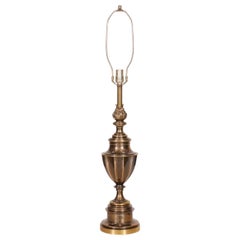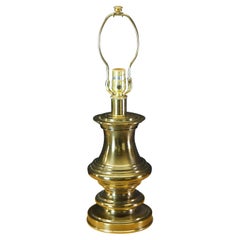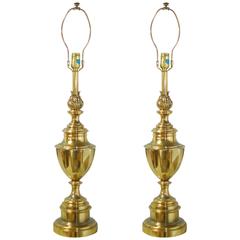Stiffel Brass Lamp Regency Trophy Urn
Mid-20th Century American Hollywood Regency Table Lamps
Brass
Recent Sales
Late 20th Century Hollywood Regency Table Lamps
Brass
20th Century American Hollywood Regency Table Lamps
Brass
People Also Browsed
20th Century American Mid-Century Modern Table Lamps
Vintage 1940s French Table Lamps
Brass
Mid-20th Century American Hollywood Regency Table Lamps
Brass
Stiffel for sale on 1stDibs
When Ted Stiffel (1899–1971) founded Stiffel in 1932 in Chicago, he wanted to make functional, thoughtfully designed table lamps, floor lamps and other fixtures that were available at an accessible price. Born in Memphis, Stiffel first pursued a career in music before serving in World War I. After his discharge, he worked with the Western Electric Company in Chicago and then the Nellie J. Kaplan Company, a lighting firm also in the Windy City.
After he started his own lamp business, Stiffel began supplying area department stores and by the 1940s had opened a large factory that was producing lamps for nationwide sale, eventually competing with the likes of the Frederick Cooper Lamp Company, also based in Chicago.
In 1948, designer Edwin J. Cole joined the company and created some of the firm’s most striking table lamps. Today, Cole’s vintage mid-century modern lighting fixtures for Stiffel, frequently with distinctively tall and shapely ceramic bodies and finished with decorative brass chinoiserie details, are highly prized by collectors.
One of Stiffel’s innovations was his patented switch, which simplified turning lights on and off: All someone had to do was grasp a lamp’s pole and gently pull down. He also designed a pole lamp with a vertical tube that held a series of fixtures on the outside. The upright pole lamp was so innovative that Sears, Roebuck and Company copied it. Stiffel sued, and the case ended up in the Supreme Court in 1964. The ruling against Stiffel was influential in whether states can give a patent to objects that do not have the invention required of federal patents.
After declaring bankruptcy in 2000, the brand was revived in 2013 in Linden, New Jersey, where newly produced high-quality lamps carry the Stiffel name.
Find a collection of vintage Stiffel lamps and other lighting for sale on 1stDibs.
A Close Look at Hollywood-regency Furniture
The California-born style of Hollywood Regency, also known as Regency Moderne, emerged during the Golden Era of cinema from the 1920s to the ’50s. Decadent and bold, vintage Hollywood Regency furniture and interiors playfully mix colors like jewel tones and hot pinks with lacquered walls, gilded accents, mirrored surfaces and metallic finishes for maximalist spaces.
Although it involved elements of the coinciding Art Deco movement, such as a preference for clean lines, Hollywood Regency was much more opulent, inspired by glamorous movie stars and the lavish set designs for films being made in Tinseltown. Furniture designers associated with the style embraced an eclectic range of influences, including throwbacks to previous styles of grandeur, such as Rococo, neoclassical and chinoiserie, as well as materials, from bamboo dining chairs to lucite bar carts to sunburst mirrors made from gilded resin. Hollywood Regency end tables, floor lamps, chandeliers and other pieces tended to be small-scale, fitting into an overall design rather than serving as a focal point.
Interior decorator Dorothy Draper led the shaping of the Hollywood Regency style and also designed iconic pieces like the España chest, which was manufactured by Henredon. Virginia native William “Billy” Haines, a furniture designer who started as an actor, contrasted hand-painted wallpaper with Chinese ceramics and Chippendale chairs, while architect John Elgin Woolf imbued his Beverly Hills designs with theatrical details. Paul Revere Williams, a trailblazing African-American architect, was pivotal in defining the look through his commercial projects, such as the 1940s Beverly Hills Hotel and bespoke homes that mixed everything from Louis XV paneling to Georgian architecture.
Find a collection of vintage Hollywood Regency bedroom furniture, tables, seating and other pieces on 1stDibs.
Materials: Brass Furniture
Whether burnished or lacquered, antique, new and vintage brass furniture can elevate a room.
From traditional spaces that use brass as an accent — by way of brass dining chairs or brass pendant lights — to contemporary rooms that embrace bold brass decor, there are many ways to incorporate the golden-hued metal.
“I find mixed metals to be a very updated approach, as opposed to the old days, when it was all shiny brass of dulled-out silver tones,” says interior designer Drew McGukin. “I especially love working with brass and blackened steel for added warmth and tonality. To me, aged brass is complementary across many design styles and can trend contemporary or traditional when pushed either way.”
He proves his point in a San Francisco entryway, where a Lindsey Adelman light fixture hangs above a limited-edition table and stools by Kelly Wearstler — also an enthusiast of juxtapositions — all providing bronze accents. The walls were hand-painted by artist Caroline Lizarraga and the ombré stair runner is by DMc.
West Coast designer Catherine Kwong chose a sleek brass and lacquered-parchment credenza by Scala Luxury to fit this San Francisco apartment. “The design of this sideboard is reminiscent of work by French modernist Jean Prouvé. The brass font imbues the space with warmth and the round ‘portholes’ provide an arresting geometric element.”
Find antique, new and vintage brass tables, case pieces and other furnishings now on 1stDibs.
Finding the Right Table-lamps for You
Well-crafted antique and vintage table lamps do more than provide light; the right fixture-and-table combination can add a focal point or creative element to any interior.
Proper table lamps have long been used for lighting our most intimate spaces. Perfect for lighting your nightstand or reading nook, table lamps play an integral role in styling an inviting room. In the years before electricity, lamps used oil. Today, a rewired 19th-century vintage lamp can still provide a touch of elegance for a study.
After industrial milestones such as mass production took hold in the Victorian era, various design movements sought to bring craftsmanship and innovation back to this indispensable household item. Lighting designers affiliated with Art Deco, which originated in the glamorous roaring ’20s, sought to celebrate modern life by fusing modern metals with dark woods and dazzling colors in the fixtures of the era. The geometric shapes and gilded details of vintage Art Deco table lamps provide an air of luxury and sophistication that never goes out of style.
After launching in 1934, Anglepoise lamps soon became a favorite among modernist architects and designers, who interpreted the fixture as “a machine for lighting,” just as Le Corbusier had reimagined the house as “a machine for living in.” The popular task light owed to a collaboration between a vehicle-suspension engineer by the name of George Carwardine and a West Midlands springs manufacturer, Herbert Terry & Sons.
Some mid-century modern table lamps, particularly those created by the likes of Joe Colombo and the legendary lighting artisans at Fontana Arte, bear all the provocative hallmarks associated with Space Age design. Sculptural and versatile, the Louis Poulsen table lamps of that period were revolutionary for their time and still seem innovative today.
If you are looking for something more contemporary, industrial table lamps are demonstrative of a newly chic style that isn’t afraid to pay homage to the past. They look particularly at home in any rustic loft space amid exposed brick and steel beams.
Before you buy a desk lamp or table lamp for your living room, consider your lighting needs. The Snoopy lamp, designed in 1967, or any other “banker’s lamp” (shorthand for the Emeralite desk lamps patented by H.G. McFaddin and Company), provides light at a downward angle that is perfect for writing, while the Fontana table lamp and the beloved Grasshopper lamp by Greta Magnusson-Grossman each yield a soft and even glow. Some table lamps require lampshades to be bought separately.
Whether it’s a classic antique Tiffany table lamp, a Murano glass table lamp or even a bold avant-garde fixture custom-made by a contemporary design firm, the right table lamp can completely transform a room. Find the right one for you on 1stDibs.
- Are Stiffel lamps made in China?1 Answer1stDibs ExpertApril 5, 2022No, Stiffel lamps are not made in China. The Stiffel Lamp Company was founded in 1932 in Chicago and throughout its many years in business, they proudly still produce all their products in America. Browse a selection of Stiffel lamps on 1stDibs.
- 1stDibs ExpertNovember 20, 2024To tell if a brass lamp is vintage, you'll need to determine if it is 20 to 99 years old by conducting online research or having an expert, such as a certified appraiser or experienced antique dealer, evaluate it. If you prefer to do the research yourself, first look for the maker's markings. Then, consult trusted online resources to identify the maker and read further to find out when the company was active and manufacturing similar lamps. Checking the plug can also be helpful. If it has two prongs of the same size, you can conclude that your lamp was made in 1962 or before, as U.S. standards set that year required all lamps to feature polarized plugs with one large and one small prong. Keep in mind that it is possible to rewire a lamp, and some makers switched to polarized plugs before the standard was established, so the lack of a non-polarized plug doesn't necessarily mean a lamp isn't pre-1962. Find a large selection of vintage brass table lamps on 1stDibs.
- Are Stiffel lamps valuable?1 Answer1stDibs ExpertFebruary 22, 2021No, Stiffel lamps are not extremely valuable. These lamps typically sell for anywhere between $100 and $500. These lamps are high quality, however, and will last a lifetime.
- 1stDibs ExpertNovember 4, 2024To identify a Stiffel brass lamp, look for the maker's markings, which may include “Stiffel Lamp Company," "SLC" or “Stiffel." Locations of markings varied over time, and they appeared in the form of both etched signatures and foiled labels. Check your lamp’s switch, shade, bulb interior, neck and base for these markings. If you can't find a Stiffel mark, it may have once had a paper label that has since become detached. In this case, a certified appraiser or knowledgeable antique dealer can assist you with the identification process. Find a selection of Stiffel lamps on 1stDibs.


